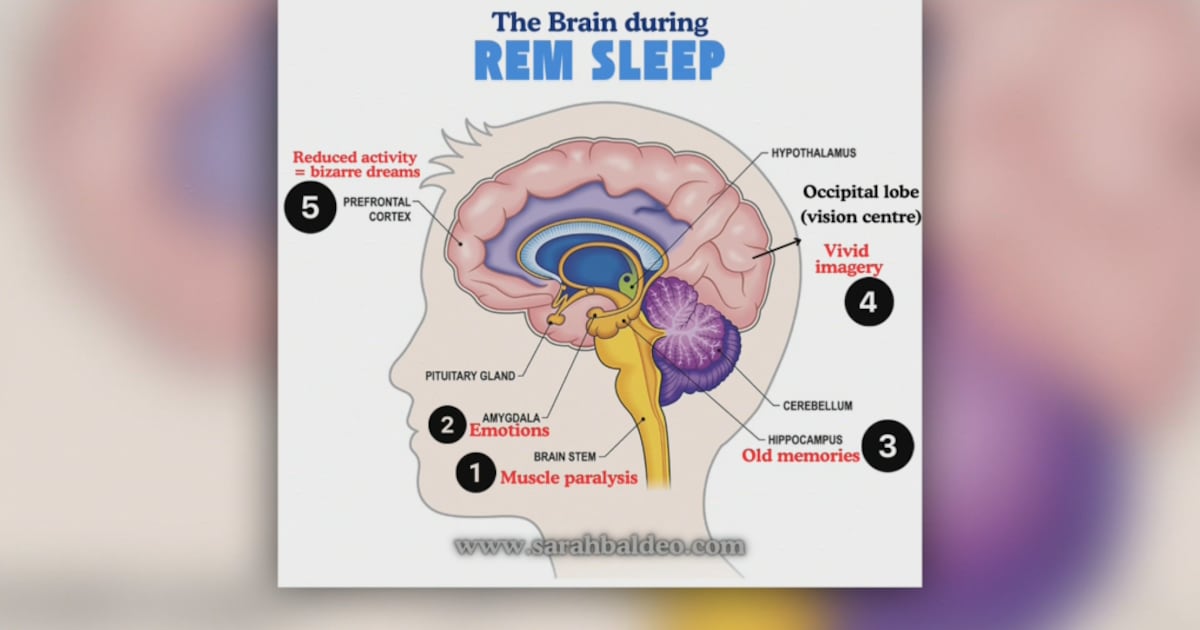Health
Neuroscientist Explores the Intricacies of Dreaming and the Brain

Neuroscientist and TED speaker Sarah Baldeo recently shared insights into the complex world of dreaming during an appearance on CTV Morning Live Edmonton. She detailed the intricate processes that occur in the brain while we dream, emphasizing the importance of understanding these phenomena.
Understanding the stages of sleep is crucial to grasp how dreaming occurs. Contrary to popular belief, dreaming does not start immediately after falling asleep. According to Baldeo, dreams primarily happen during a specific phase known as rapid eye movement (REM) sleep. To reach this stage, individuals must first navigate through three distinct stages of sleep. Once in REM, several key areas of the brain become active.
Baldeo identified five significant regions involved in dreaming. The first is the brain stem, which paralyzes muscles to prevent sleepwalking. The amygdala is the second area, responsible for the emotional intensity often felt in dreams. The hippocampus, which activates memories, plays a crucial role in recalling short-term and long-term experiences. The occipital lobe, located at the back of the brain, is responsible for visual experiences during dreams, contributing to their vividness. Finally, the prefrontal cortex, located at the front of the brain, shows reduced activity during dreaming, explaining why dreams can appear nonsensical.
During the segment, host Kent Morrison inquired about the purpose of dreaming. Baldeo explained that dreams serve to help individuals process their waking lives and emotions. She noted that dreaming aids in purging neurotoxins that accumulate throughout the day, underscoring the importance of both the quality and quantity of sleep.
The question of whether dreams hold meaning is a common one. Baldeo addressed this by stating that while many people desire to believe they possess psychic abilities, scientifically, dreams reflect the brain’s effort to identify patterns based on daily experiences. Instances where a dream seems to predict a future event often stem from confirmation bias, where individuals remember the dreams that align with reality while forgetting those that do not.
Recent advancements in technology have led to innovations in dream recording. Baldeo mentioned research conducted in Kyoto, Japan, where scientists are using artificial intelligence algorithms and functional magnetic resonance imaging (fMRI) to analyze brain activity during dreaming. This process aims to recreate dream experiences for playback, resembling a movie. Baldeo expressed excitement about this development but cautioned that it is still in its early stages. The implications of such technology remain uncertain, particularly concerning individual sleep patterns and the accuracy of dream playback.
In summary, Baldeo’s exploration of dreaming sheds light on the fascinating workings of the human brain. As research continues to evolve, the potential for understanding dreams more profoundly remains promising, although many questions still linger about their significance and the implications of new technologies in this realm.
-

 Science3 months ago
Science3 months agoToyoake City Proposes Daily Two-Hour Smartphone Use Limit
-

 Top Stories3 months ago
Top Stories3 months agoPedestrian Fatally Injured in Esquimalt Collision on August 14
-

 Health3 months ago
Health3 months agoB.C. Review Reveals Urgent Need for Rare-Disease Drug Reforms
-

 Technology3 months ago
Technology3 months agoDark Adventure Game “Bye Sweet Carole” Set for October Release
-

 World3 months ago
World3 months agoJimmy Lai’s Defense Challenges Charges Under National Security Law
-

 Lifestyle3 months ago
Lifestyle3 months agoVictoria’s Pop-Up Shop Shines Light on B.C.’s Wolf Cull
-

 Technology3 months ago
Technology3 months agoKonami Revives Iconic Metal Gear Solid Delta Ahead of Release
-

 Technology3 months ago
Technology3 months agoApple Expands Self-Service Repair Program to Canada
-

 Technology3 months ago
Technology3 months agoSnapmaker U1 Color 3D Printer Redefines Speed and Sustainability
-

 Technology3 months ago
Technology3 months agoAION Folding Knife: Redefining EDC Design with Premium Materials
-

 Business3 months ago
Business3 months agoGordon Murray Automotive Unveils S1 LM and Le Mans GTR at Monterey
-

 Technology3 months ago
Technology3 months agoSolve Today’s Wordle Challenge: Hints and Answer for August 19









